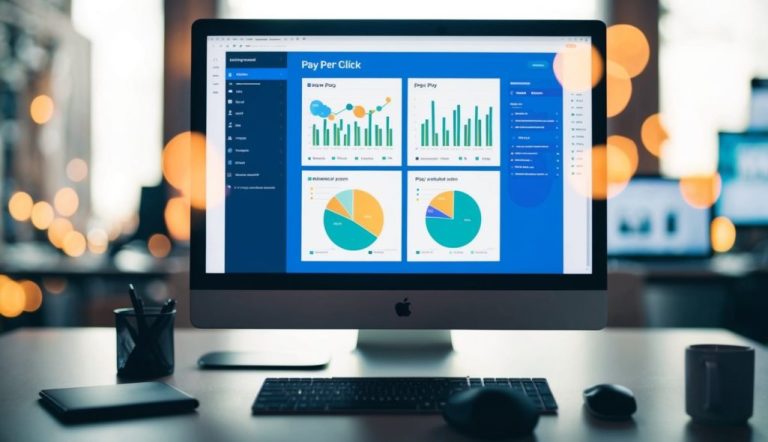Earning money through pay-per-click (PPC) advertising is a viable path for many looking to make money online. If you set up your PPC campaigns effectively, it can become a steady income source. By understanding the core principles of PPC, you can create optimized strategies to boost your earnings.

Getting started with PPC requires careful planning and setup. From selecting the right keywords to designing high-converting ads, every step matters.
Your choice of platforms and networks is also crucial, whether it’s through Google Ads or lesser-known networks that could fit your niche better.
Key Takeaways
- Learning PPC basics helps set a strong foundation.
- Strategic ad placement optimizes earnings.
- Choosing the right programs increases your success.
Understanding Pay-Per-Click Advertising
Pay-Per-Click (PPC) advertising is a popular digital marketing model where you pay each time someone clicks on your ad. It offers a way to quickly drive traffic to your website. This approach is used across various platforms like Google Ads, Facebook Ads, and more.
History and Evolution of PPC
PPC advertising began in the late 1990s with the introduction of search engines. Early programs charged advertisers based on the number of times their banners were viewed. By 2000, Google launched Google AdWords, revolutionizing PPC by allowing advertisers to target specific keywords and only charging when ads were clicked. This shift made PPC more cost-effective and popular among businesses. The model evolved to include various formats, adapting to the growing needs of digital marketers and the expanding online ecosystem.
Key Components of the PPC Model
In PPC campaigns, you focus on several key components. First, keywords are essential. You bid on these, and they determine when your ads show up.
Next, your ad’s quality score affects its position and cost. The score is based on relevance and user experience.
Ad groups help organize your campaigns by grouping similar ads. Managing bids and budgets ensures that your spending aligns with your goals and that you get the best return on investment.
Different Types of PPC Advertising
There are several types of PPC advertising you can use. Search ads appear on search engine results pages, triggered by keywords you bid on.
Display ads are shown on websites and can include text, images, or video formats.
Social media platforms, like Facebook and YouTube, offer video and image ads that appear in users’ feeds or before videos. Each type serves different purposes and can be aligned with specific business goals, whether it’s brand awareness, lead generation, or driving website traffic.
Roles of PPC in Digital Marketing
PPC plays a vital role in digital marketing strategies. It allows you to target specific audiences effectively and achieve immediate results, unlike slower methods like SEO.
Using PPC, you can increase brand visibility and reach potential customers at various stages of the buying process. This method complements other marketing efforts, like social media and email, to create a comprehensive marketing plan.
PPC helps businesses, both small and large, compete in the digital space by leveling the playing field regardless of company size.
Setting Up a PPC Campaign
Setting up a successful PPC campaign requires careful planning and execution. You’ll need to focus on platforms like Google Ads, choose the right keywords, create compelling ad copy, and ensure that your landing pages provide a seamless experience for visitors.
Starting with Google Ads
Getting started with Google Ads is essential for most PPC campaigns. First, you will need to create a Google Ads account. This allows you to access Google Ads services and tailor them to your needs.
You can begin by deciding on your campaign’s goals. Whether it’s increasing web traffic or boosting sales, setting clear objectives helps guide your decisions.
Once your account is set up, familiarize yourself with AdWords tools. These include targeting options, budget settings, and ad formats. The features enable you to reach your audience more effectively.
Machine learning within Google Ads can also optimize your campaign performance by automatically adjusting bids for best results.
Keyword Research and Selection
Choosing the right keywords is crucial for driving targeted traffic to your site. Start by using tools like Google Keyword Planner to find relevant keywords. This tool helps identify search terms your audience is likely using.
Focus on both broad and long-tail keywords. While broad keywords reach a wider audience, long-tail ones can bring more specific traffic. Avoid overly competitive keywords that might consume your budget quickly.
The relevance of your keywords affects your Quality Score, which determines your ad’s position and cost-per-click. High-scoring keywords indicate better relevance and higher potential returns.
Crafting Effective Ad Copy
The ad copy is your first direct interaction with potential customers. It’s crucial to make it clear and engaging.
Start by including relevant keywords in the headline and description. This not only improves visibility but also resonates with search intent.
Ensure your ad copy has a strong call-to-action (CTA). Encouraging users to click through to your site with action-oriented words can boost engagement. Keep your messaging concise yet informative.
Use Google AdSense’s tools to experiment with different versions of your ad copy. A/B testing helps you discover which phrasing and CTAs work best for your target audience.
Importance of Landing Page Experience
A smooth landing page experience is crucial for converting clicks into sales. Ensure your landing page aligns with the promise of your ad. This means consistent messaging, tone, and products or services being highlighted.
Focus on fast loading times and mobile optimization. Users are likely to leave slow or poorly designed pages quickly. Track changes in bounce rates and use this data to improve the experience.
Google also factors landing page quality into its Quality Score, impacting the cost and visibility of your ads. A high-quality landing page can reduce costs and enhance your campaign effectiveness.
Maximizing PPC Campaign Performance
Effective Pay-Per-Click (PPC) strategies require focusing on key aspects like click-through rates, ad relevance, and conversion optimization. Techniques such as using machine learning can enhance efficiency and performance.
Optimizing for High Click-Through Rates
A high click-through rate (CTR) indicates that your ads are engaging and relevant. To boost CTR, focus on making your headlines catchy and your descriptions clear. Use specific calls to action and highlight benefits that draw attention.
Your ad formats play a crucial role too, so consider using ad extensions like sitelinks or call buttons to increase visibility and appeal.
Running A/B tests can be beneficial. By testing different versions of your ads, you can identify what resonates best with your audience. Consistently monitor and adjust your ads based on analytics. Pay attention to metrics such as click-through rate and cost per click (CPC) to ensure your campaigns remain cost-effective and effective.
Enhancing Ad Relevance and Quality
Ad relevance is crucial for maintaining high PPC performance. Ensure that your ads align closely with the keywords you are targeting.
Use dynamic keyword insertion to make your ads more relevant to users’ searches. This technique automatically updates your ads with the searcher’s query, increasing the likelihood of engagement.
Create ad groups with tightly themed keywords. This helps improve the quality score, which can lower your cost per click and improve ad positioning.
By closely aligning ad copy with user intent, you greatly enhance user experience and ad performance. Always keep your landing pages aligned with ad messaging to ensure a seamless flow from click to conversion.
Conversion Rate Optimization
Improving conversion rates is essential for generating revenue from PPC campaigns.
Start by refining landing pages. They should be user-friendly and load quickly to prevent drop-offs. Use persuasive language and clear calls to action that guide users towards completing your desired outcome.
Leverage data-driven insights to tailor your strategies. Analyze user behavior to identify sticking points in the conversion process.
Offering incentives such as discounts or free trials can also encourage users to convert. Test different versions of your landing pages, headlines, and calls to action to determine what works best.
Paying attention to user experience can significantly boost conversion rates over time.
Using Machine Learning for PPC Efficiency
Incorporating machine learning in PPC can greatly enhance performance.
Algorithms can help with automation, optimizing bids, and improving targeting options.
By analyzing large datasets, machine learning tools provide data-driven insights. These insights allow you to make adjustments that increase efficiency and effectiveness.
Automated bidding strategies can balance between spending and achieving conversion goals. Machine learning can also assist in predicting future trends and maximizing your reach.
This technology helps create more personalized and relevant ads by identifying patterns in user preferences. Using machine learning allows you to evolve with the market and maintain a competitive edge.
Exploring PPC and Affiliate Marketing Synergy
Pay-per-click (PPC) and affiliate marketing can complement each other, creating significant opportunities for earning income. Understanding how these strategies intersect helps in leveraging their benefits effectively.
Introduction to Affiliate Marketing
Affiliate marketing involves promoting products or services for a commission. You promote these through unique affiliate links. When someone makes a purchase using your link, you earn a percentage of the sale.
This method is popular due to its low upfront costs and flexibility. By choosing the right products that align with your audience’s interests, you can increase your potential earnings significantly. Being part of reputable affiliate networks like Skimlinks can further enhance your success.
Comparison of PPC and Affiliate Marketing
While both PPC and affiliate marketing aim to generate clicks and conversions, they function differently.
PPC involves paying for ad placements to drive traffic to a particular site or offer, often through platforms like Google AdSense. On the other hand, affiliate marketing relies on earning through commissions rather than paying upfront.
The key distinction lies in the cost model: PPC is upfront, while affiliate payments are based on performance. Ready strategies in both fields can maximize earnings by aligning with specific goals.
PPC for Affiliate Link Promotion
Using PPC to promote affiliate links can expand your reach. By investing in paid ads, you can draw targeted traffic to your site and increase the chances of conversions.
Platforms like Mediavine are known for high returns per click. Proper keyword research and selecting the right ad placements play crucial roles in this strategy. Clear and compelling ad copy is also essential. Monitoring your ad performance and optimizing regularly ensures sustained profitability.
Choosing the Right Affiliate Networks and Programs
Selecting appropriate affiliate networks is vital for success.
Networks like Amazon Associates, Skimlinks, and Mediavine offer extensive product selections and reliable tracking systems.
Evaluate the commission structures and cookie durations carefully to decide which aligns best with your goals. You may want to consider programs that offer flexibility and support, ensuring you have the tools needed to drive sales and earn substantial affiliate income. Being strategic in your selections helps build a sustainable business model.
Monetizing with Pay-Per-Click Programs
Pay-per-click (PPC) advertising offers several ways to earn money online. Through PPC programs, you can place ads on your website and get paid for each click. You can also join affiliate programs and benefit from various monetization models.
Overview of PPC Monetization Models
PPC monetization primarily involves displaying ads on your website. When visitors click on these ads, you earn a portion of the ad revenue.
Common models include Cost Per Click (CPC) and Cost Per Mille (CPM), where CPC pays you for each click, and CPM rewards you for every 1,000 ad impressions.
Revenue sharing programs with providers like Media.net allow you to embed contextually relevant ads. The key is understanding which models align best with your website’s traffic to maximize earnings.
Earning Through PPC on Your Website
To earn money by clicking on ads, you need a steady flow of visitors. More traffic typically translates to more clicks. Program options like Ezoic and AdThrive help optimize ad layouts and placement, which can improve click-through rates (CTR) and earnings.
You should experiment with various ad sizes and positions to see what works best. Avoid having too many ads, as they can negatively impact user experience. Balance is key to ensuring both user satisfaction and revenue generation.
Joining Various PPC Programs
Several programs allow you to make money with pay per click advertising. Google AdSense is a popular option known for its vast network of advertisers. It’s competitive, but offers a straightforward setup.
Alternative programs include Infolinks and Media.net, each with unique features and requirements. To succeed, research each platform to find one that matches your content style and audience profile, allowing you to maximize profits effectively.
Calculating the Earning Potential
Calculating how much you can earn with PPC takes careful planning. Consider your website’s traffic, your chosen PPC program’s rates, and visitor engagement levels. Use analytics tools to track views, clicks, and revenue.
For example, if a program offers $0.10 per click and you have 1,000 clicks, you make $100. Consider estimations based on CPM or CPL models too, to get a broader view of potential earnings. Regularly reviewing this data will help you adjust strategies and choose the right program for maximum profit.
Strategic Ad Placement and Network Choices
When it comes to maximizing your earnings with pay-per-click (PPC) advertising, careful selection of both ad placement and networks is key. By exploring different options and leveraging the tools available, you can achieve better visibility and engagement.
Selecting the Right Ad Placement
Choosing the ideal ad placement can significantly impact your ad’s performance. Placing your ads on high-traffic websites or popular blog pages can enhance visibility. Consider utilizing Google AdSense to access a vast network of sites, offering varied placement choices tailored to your targets.
Focus on sites where your audience frequently visits. Understand their preferences and select placements that ensure your ads are seen by the right people at the right time, increasing click-through rates and driving conversions.
Diversifying Ad Networks
Using multiple ad networks can help you reach wider audiences and reduce dependency on a single platform. Networks like Media.net, Adsterra, and RevenueHits each offer unique features that can enhance your campaign’s reach and effectiveness.
With diversification, you can compare performance and allocate budget to the best-performing networks. This method not only broadens your audience but also tests different strategies and formats, helping to optimize your return on investment.
Comparing Top PPC Networks
Understanding what each PPC network offers is crucial for optimizing ad spend. Google AdSense is one of the most popular networks, providing access to a massive audience. Meanwhile, Media.net is known for its contextual advertising, offering high relevancy and engagement.
Other networks like Adsterra and RevenueHits focus on innovative ad formats, including video and native ads. Evaluating these options can ensure you choose networks that align with your goals and budget, increasing the potential for higher returns.
Leveraging Native Advertising
Native advertising seamlessly blends with website content, providing a non-intrusive way to reach your audience. Platforms like Outbrain specialize in native ads, helping you engage users without disrupting their browsing experience.
This approach often results in higher engagement rates because the ads feel less like traditional advertising. It’s essential to craft compelling and relevant content that resonates with your audience, making native advertising an effective tool in your PPC strategy.
Frequently Asked Questions
When using pay-per-click (PPC) methods to make money, it’s important to know which affiliate programs offer the best opportunities. You’ll also need tips on how to earn from home and understand the potential earnings per click.
What are the highest paying pay-per-click affiliate programs?
Some popular PPC affiliate programs include Google’s AdSense and Media.net. These platforms are widely used for monetization due to their high payout rates and broad advertiser base. Look for programs with a good reputation and pay rates that align with your goals.
How can one earn money from home using pay-per-click?
You can earn from home by setting up PPC campaigns on platforms like Google Ads and Facebook Ads. These campaigns involve creating enticing ads that attract clicks, leading to revenue. Consider using targeted strategies to increase your potential earnings.
Are there legitimate pay-per-click opportunities that are free to start?
Yes, there are PPC opportunities where you can start without upfront costs. Some platforms allow you to join and create campaigns without paying initial fees. Always research to ensure the opportunity is credible and offers real earning potential.
What is the average earning potential per click in pay-per-click programs?
Earnings per click can vary widely. On average, you might earn a few cents to several dollars per click, depending on the niche and competition. High-demand keywords tend to yield better returns, while more common keywords might have lower earnings.
How does pay-per-click work, and is it a viable way to make money online?
PPC works by placing ads where potential customers are likely to see them, and you pay when someone clicks on your ad. It’s a viable option for those who understand digital marketing and are willing to invest time in learning and optimizing their campaigns.
Can you get paid for each click on your personal affiliate link, and how?
Yes, you can earn money from clicks on your personal affiliate link through programs like affiliate marketing.
By sharing these links on your blog or social media, you earn a commission when someone clicks and makes a purchase.





